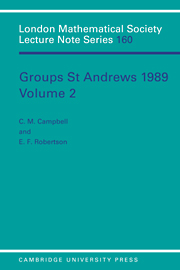Book contents
- Frontmatter
- Contents
- Preface
- Introduction
- 17 A survey of recent results on projective representations of the symmetric groups
- 18 Some applications of graded diagrams in combinatorial group theory
- 19 Rational growth of wreath products
- 20 The modular group and generalized Farey graphs
- 21 On the n-centre of a group
- 22 Existentially closed finitary linear groups
- 23 Permutability and subnormality of subgroups
- 24 Some applications of powerful p-groups
- 25 Combinatorial aspects of finitely generated virtually free groups
- 26 Problems in loop theory for group theorists
- 27 Sylow theory of CC-groups: a survey
- 28 On the minimal number of generators of certain groups
- 29 Lie properties of modular group algebras
- 30 Observations on a conjecture of Hans Zassenhaus
- 31 The Fibonacci groups revisited
- 32 Galois groups
- 33 Infinite simple permutation groups - a survey
- 34 Polynomial 2-cocyles
23 - Permutability and subnormality of subgroups
Published online by Cambridge University Press: 13 March 2010
- Frontmatter
- Contents
- Preface
- Introduction
- 17 A survey of recent results on projective representations of the symmetric groups
- 18 Some applications of graded diagrams in combinatorial group theory
- 19 Rational growth of wreath products
- 20 The modular group and generalized Farey graphs
- 21 On the n-centre of a group
- 22 Existentially closed finitary linear groups
- 23 Permutability and subnormality of subgroups
- 24 Some applications of powerful p-groups
- 25 Combinatorial aspects of finitely generated virtually free groups
- 26 Problems in loop theory for group theorists
- 27 Sylow theory of CC-groups: a survey
- 28 On the minimal number of generators of certain groups
- 29 Lie properties of modular group algebras
- 30 Observations on a conjecture of Hans Zassenhaus
- 31 The Fibonacci groups revisited
- 32 Galois groups
- 33 Infinite simple permutation groups - a survey
- 34 Polynomial 2-cocyles
Summary
The main purpose of this survey article is the presentation of a result of the author's paper: Zur Vertauschbarkeit und Subnormalität von Untergruppen, which appeared in Archiv der Mathematik 53 (1989), 110–120.
The result was obtained while the author was visiting the University of Tübingen during a sabbatical semester in 1987.
For common concepts and notation which we shall use in this report, see introductory books in finite group theory, for example [G].
Introduction to the problem
If G is a group and if A, B are subgroups of G, the subgroup <A, B> of G generated by A∪B is of interest. Due to the fact that a group is a noncommutative algebraic structure, it is impossible in general to predict some special property of <A, B> only by the knowledge of the internal properties of the generating subgroups A and B. For example, two cyclic subgroups may generate a highly complicated simple group.
To be able to control the properties of the group <A, B> by those of A and B, the generation of <A, B> must happen in a special way. The most transparent case we have is when <A, B> coincides with the product set AB = {ab|a ∈ A, b ∈ B}. It is well known that this holds if and only if AB = BA. Two subgroups A and B of a group G which have this property, are called permutable. A sufficient condition for the permutability of A and B is that A normalizes B (that is, a−1ba ∈ B for all a ∈ A, b ∈ B) or vice versa.
- Type
- Chapter
- Information
- Groups St Andrews 1989 , pp. 363 - 369Publisher: Cambridge University PressPrint publication year: 1991



